
Feature: Jaguar E-Type Zero An exclusive ride in a classic E-Type with a modern electric twist. The most beautiful electric car in the world Words: Beth Lily Georgiou Photos: Jaguar & Drive-My .
MAIN Jaguar Classic Works did what many would consider the unthinkable, by installing an electric motor in an original Jaguar E-Type.
It’s a crisp winter day in the British countryside and Jimmy Hendrix plays in the background. Beth Lily Georgiou is about to experience the swinging sixties as it has never been experienced before.
Setting the scene
The Jaguar E-Type, dubbed “the most beautiful car” by Enzo Ferrari during its debut at the 1961 Geneva Motor Show, exudes an ethereal presence that inspires emotion in just about anyone that comes into contact with one.
The E-Type was originally influenced by the triple Le Mans winning D-Type from the 50s and was an absolute phenomenon at Geneva where it was launched, shaking the automotive industry to the core. The E-Type has been a classic icon for nearly 60 years and is still well loved today.
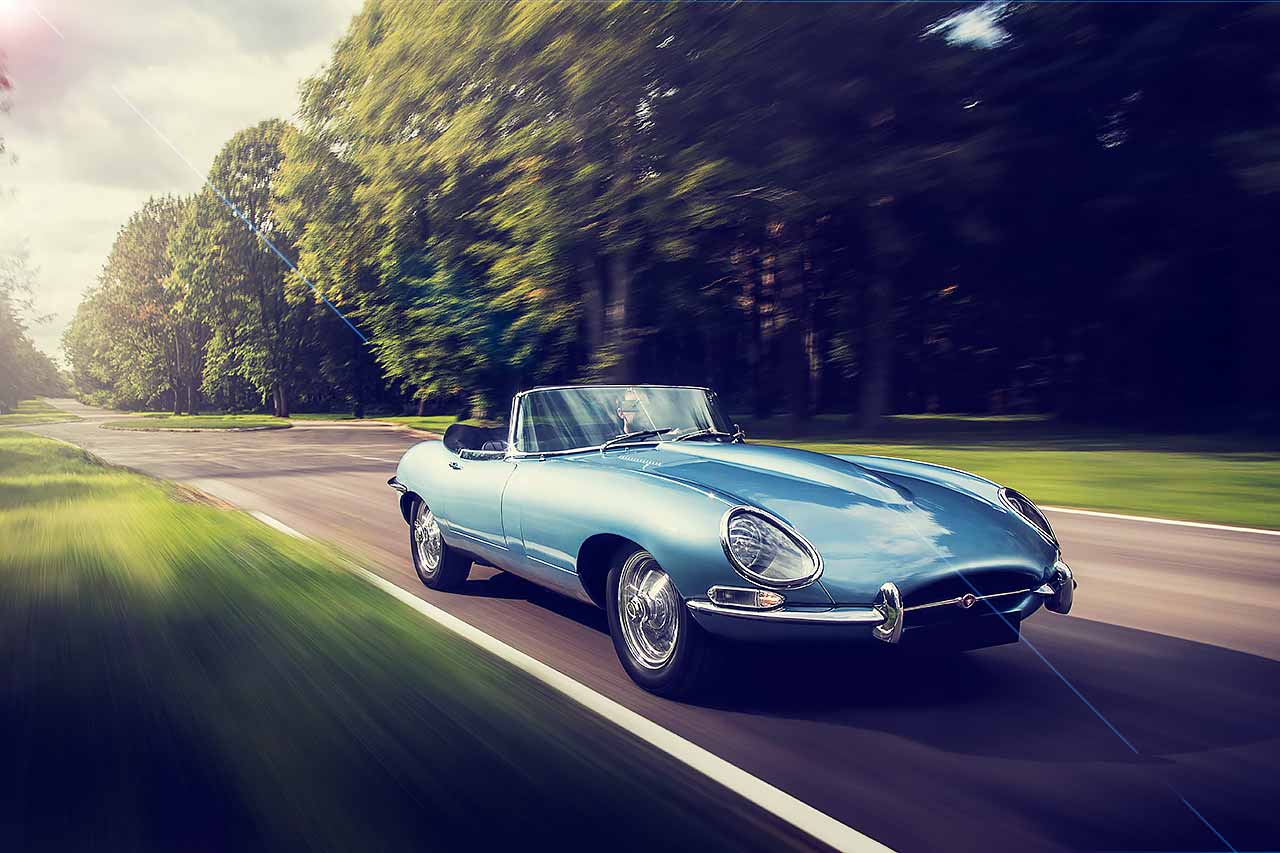
In September 2017, Jaguar surprised the automotive world by releasing the E-Type Zero concept; an allelectric conversion of the beloved classic. The concept sees the XK6 engine replaced with an electric powertrain, yet is designed to retain the driving experience of the original model.
Jaguar Classic Works is the stuff of dreams for any car enthusiast, filled with vehicles ranging from the first ever Land Rover, which I’m told was recently discovered in a hedge after being missing for many years, to forgotten 90’s supercars.
From restorations to conversions, to storage and even a warehouse full of Jaguar’s own classic car collection, Jaguar Classic is a perfectionist’s heaven. Each customer deals with a sole master-builder who works on their car and the emotional attachment these master-builders have to the vehicles they work with is evident in the meticulous detail and artistry evident on the workshop floor.
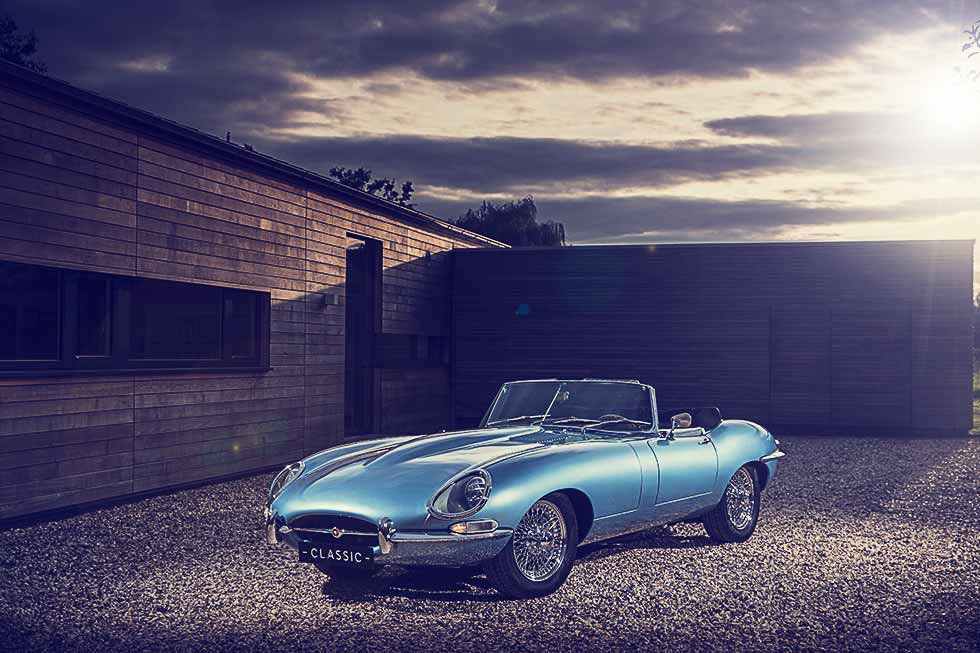
It is, therefore, the ideal location to experience the Jaguar E-Type Zero.
The technical details
Offering pure driving pleasure, the E-Type Zero feels like it would be best suited to winding country roads and a warm summer’s breeze, but I am more than happy to experience its drivability on a typically British rainy winter’s day, as I’m taken on a tour of the local roads. The E-Type master-builder accompanying me explains that in terms of the chassis and suspension, no modifications have been made in order to maintain as much of the original character as possible.
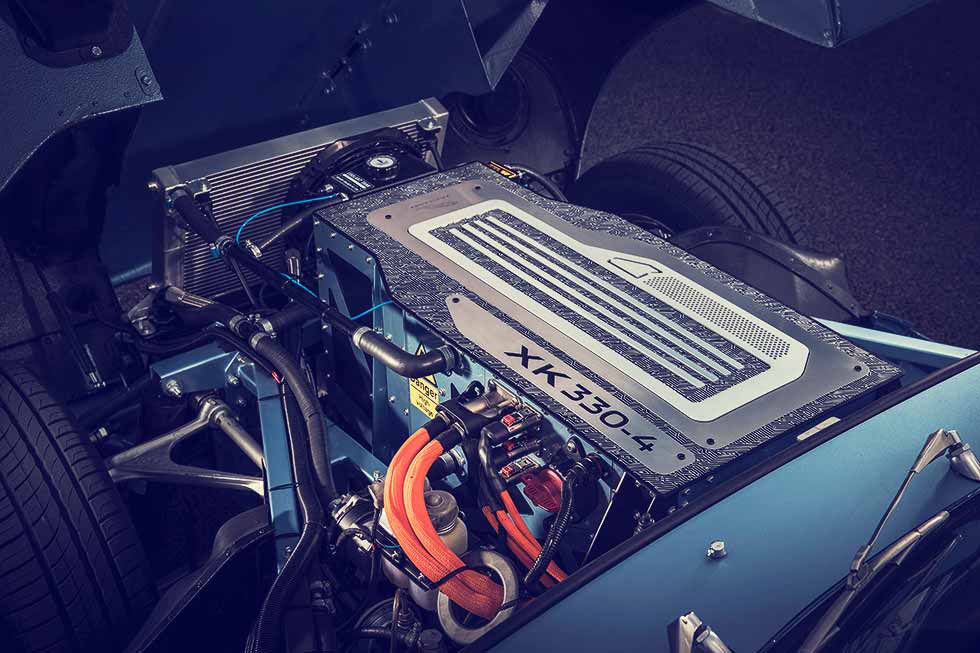
The 40kWh battery pack sits exactly where the engine once sat, mounted to the original engine mounts. It has a nominal 600V and a usable capacity of around 36kWh. Because the car is light, has a fairly low frontal area and low rolling resistance it ends up with a useful range of around 170 real world miles. Performance is taken care of with a respectable 0-60 time of 5.5 seconds. The motor gearbox sits in the transmission tunnel and drives the original prop shafts and differential. There are three distinct cooling systems present: for the battery, the high-voltage electronics, and the motor gearbox.
The power electronics in this particular car are in the boot, with inverter for the main motor drivers, the converter and two 3.5kW chargers stacked one on top of the other. AC-only charging on this car is 7kW via a standard socket neatly positioned under the fuel filler flap.
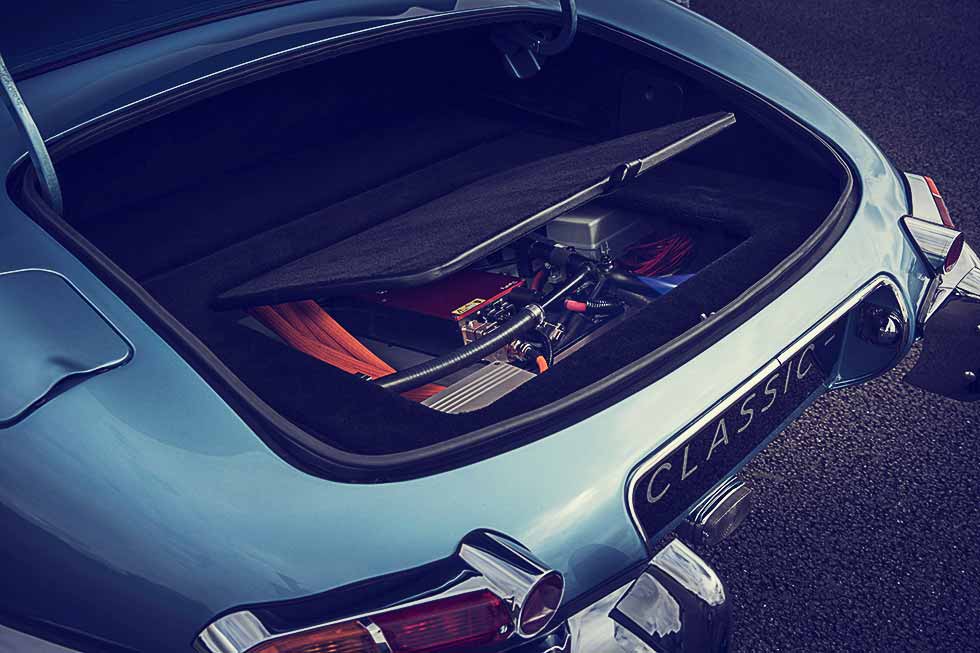
Interestingly, the electric drivetrain is capable of more power than Jaguar has it dialled up to. The car offers 220kW with 450Nm of torque, but it could be pushed to over 300kW. As for its looks, it has been done sympathetically and is a reasonably straightforward install, fitting in nicely with the Jaguar’s vision. The team managed to get the E-Type Zero within 1% of the original vehicle’s weight, and with a near perfect 50/50 weight distribution. More impressive is overall weight ended up lighter in electric form than the original car.
“A bit of a beast, really”, the engineer explains of the original straight-six that weighed in at around 240kg. The gearbox and firewall were also heavy and once the exhaust, fuel tank, spare wheel etc. had been removed the car was around 360kg lighter. Weight saving often falls in favour for classic electric conversions where an electric powertrain is often lighter than the original components it replaces.
Modernised interior
To a classic car enthusiast, the exposed carbon fibre dash and 3D printed centre console combined with the old wooden steering wheel might be a bit marmite, but there’s no doubting the class Jaguar has applied to this history-meets-future aesthetic. The E-Type Zero comes complete with a digital instrument pack and a touch screen infotainment system for media playback and some additional system parameter setups that help make the car that much easier to live with in a modern world.
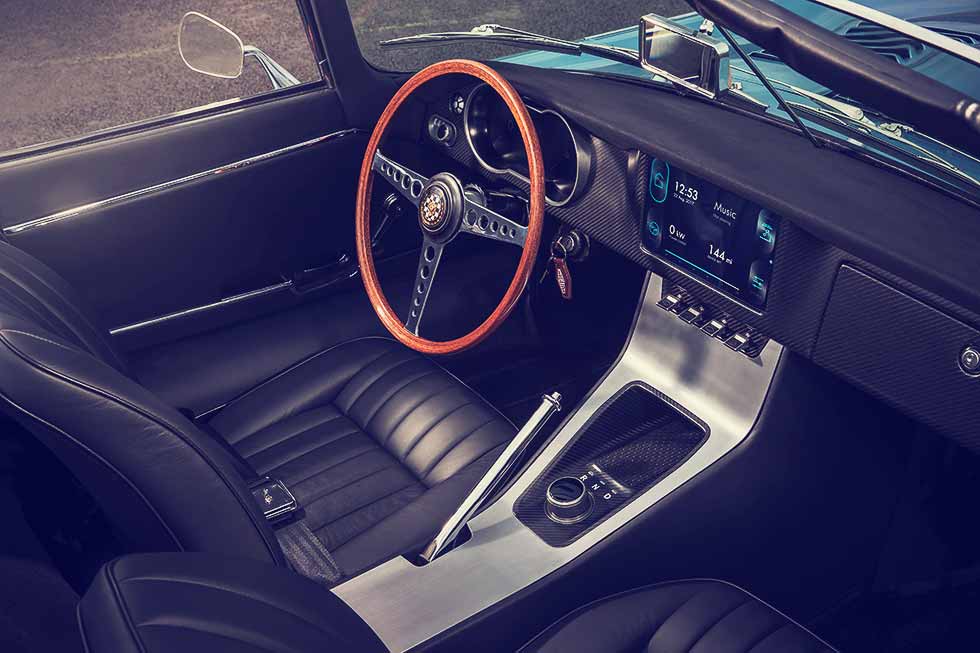
On the road
The E-Type Zero prowls on the road with a level of elegance that simply can’t be recreated in a modern car. It’s smoother than jazz (although my entrance into the car certainly isn’t) and for a car of fifty years, it is surprisingly quiet. The motor has a unique tonal whistle, but mechanical bangs and squeaks are absent thanks to Jaguar Classics tinkering. In fact, the 4 year old Tesla I arrived in is far louder. The steering is rewardingly firm: I never tire of complaining about modern overassisted steering, but this is definitely not the case here.
The engineers at Jaguar Classic have worked hard to ensure the driving experience feels authentic, and they have done a good job of giving the feeling of being transported back to the sixties, without the worry of scary maintenance levels or unreliability. Ultimately, this beautiful classic becomes more usable with the electric powertrain, whilst retaining its charm and dignity.
Recyclability equals sustainability
The E-Type Zero doesn’t just deserve credit for its Zero Emission status. One of the most impressive things is that typically 85% of the old parts are recycled back into other vehicles. The “messy corner” of the workshop, as it is fondly described, houses parts awaiting cleaning, repair and ultimately reusing, which of course is also sustainable and efficient. Initially, I’m told this was unintentional, but this level of recycling and reuse has really added to Jaguar Classic’s sustainability efforts.
Early conclusion
Enzo Ferrari was right; the E-Type is absolutely flawless in its beauty. Whereas sports cars of today are designed to reflect their power within, the E-Type seems gentle and unassuming, aided of course by its compact size.
The pastel blue (an original colour) is strangely futuristic and forward thinking for a fifty-year old vehicle and befitting of its new electric powertrain too. Silence only enhances its beauty.
That, paired with the ability to keep up with modern traffic, is a unique and incredible vehicle. This is a car I would drive again in a heartbeat… albeit I’d prefer to do so in less wet conditions to truly appreciate the open-top experience accompanied by electric bliss.
I’d give my right arm to have one of these beautiful silent friends in my garage.
Turning concept into reality
Experiencing the E-Type Zero felt like a once in a lifetime opportunity, because this is a special proof of concept, but Jaguar has hinted at wanting to take this project further than being just a one-off.
In short, in order to make more of these amazing electric classics, Jaguar needs to hear from people who like the idea or would consider buying one. The price should be around the same as that of a restored E-Type (a cool £300-£350k) but that is, sadly, speculative. So if like me the E-Type Zero is your dream car, let Jaguar know via their website or on social media and maybe they’ll get moving on making their next one.
CLOCKWISE FROM TOP LEFT Gentle modernisation of the interior equips it with mod-cons; Components hidden under the boot floor; Charging socket is neatly tucked away under the petrol filler flap. The E-Type Zero prowls on the road with a level of elegance that simply can’t be recreated in a modern car.
OPPOSITE An ordinary E-Type from the outside, hides a very different animal.
Q+A with Tim Hannig
We changed the name to Project Dylan because of Bob Dylan switching from acoustic to electric guitar! Q+A with Tim Hannig. Experiencing the E-Type Zero itself was an unforgettable experience, but there was more to learn from Tim Hannig, Director at Jaguar Land Rover Classic, about the key drivers that inspired him and the team. Words: Beth Lily Georgiou. Photos: Jaguar.
BLG: How did the E-Type Zero concept come about and what inspired the project?
Th: To be honest I had the idea before I joined the company, because at the end of the day we have a few major things. The first is regulation and legislation that might make combustion engine cars prohibited in certain areas, in particular metropolitan areas where there are many people living, of which some will own these cars and love these cars. So what are these people going to do? Could this mean we would see less or no classic cars? That would be a massive shame, as a classic car is an equaliser for everyone – people like them and are happy to see them even if they don’t own them. It is a nice thing to see and be around and it would be very sad to see numbers decrease, so this was one side we were thinking about.

The other thing is, we have a changing generation and people are actually looking for a higher level of convenience. They love the style of classic cars, but to what extent do they still want to deal with carburettors, leaking oil, and all those sorts of things that come along with a car from the 50s, 60s, or even 70s? So we were wondering how we could future-proof it from a technical side.
On the other hand, we are all people working here and we simply thought it was a pretty cool idea. So the project had this playfulness about it from the start. An enormous amount of people, for varying reasons, said it couldn’t be done.
We set really complicated parameters like minimum range and we couldn’t impact on the space available for the driver, or any impact on the structure. Lots of people said this would not be possible; that the car wouldn’t go far enough or accelerate fast enough, so we actually came to the point where we decided we just needed to go ahead and build one to prove the concept. So that’s what we did.
BLG: I heard rumours that the project codename was Project Marmite?!
Th: Yes, it is true, because of course you either love it or you hate it. But actually then we changed the name to Project Dylan because of Bob Dylan switching from acoustic to electric guitar!
BLG: Were there any particular technical difficulties?
Th: The majority of difficulties came down to packaging. Often classic cars have lots of room in some areas and next to no room in other areas. For example, in the E-Type the transmission tunnel is really tight, so that was quite difficult. Trying to keep the weight distribution sensible was also difficult.
On the plus side, the team have complete flexibility with the tuning, which you don’t necessarily have with internal combustion engines, so actually in some ways they had even more freedom.
BLG: Is there a cost difference between building a restored E-Type and building the E-Type Zero?
Th: Our target would be that it would be no different. We think that we will be able to achieve it for the reason that when we restore a perfectly original combustion engine car, we need to find a base car that contains the original engine etc. whereas if a customer wants an electric one we can go for a car that has a non-original engine and therefore a lower market value. So we purchase these cars for a lower price and that means that the total can be the same, because we have started from a lower price point.
Actually the transmission itself overall is substantially more expensive, so we need that delta, but in an ideal world, if you would like a restored E-Type from us then the combustion option and electric option would be the same price.
BLG: Would you offer conversions for existing E-Type owners?
Th: This would be the ideal scenario and something we would very much like to be able to do. Most importantly to us, we would like this to be reversible. We would take the engine, gearbox, and radiation system etc. out of the car, document it properly, and crate it so the customer can take it with them or we might even store it here, then put the new electric heart into it. Then if ever the customer sells the vehicle, it could go with both transmissions, or if they change their mind and want the combustion engine back, we can actually do that for them.
So the concept is completely reversible technology, which I think is actually really important because then it doesn’t mean the decision is forever. You could even switch – probably not every year – but in theory whenever you liked.
BLG: I think that is one of the key selling points of this concept. In particular, to the classic car enthusiast audience, who might be wondering why bother converting this car at all.
Th: Yes, you are totally right, the engines are actually really fine and my dream garage would be one of each version. I want an electric one and a standard one and depending on my mood I would decide which one to take.
BLG: Any borrowed tech from the I-Pace in this car?
Th: No, there’s not a lot of borrowed tech from the I-Pace in this car at all, other than from a control strategy point of view. In terms of physical hardware, the E-Type Zero is completely bespoke. This was due to space and because we needed such a quick turnaround for this car, compared to the I-Pace.
BLG: What are the performance differences between a fully refurbished E-Type and the E-Type Zero?
Th: The performance difference is mainly that the electric version will be slightly faster in terms of acceleration.
That is not because of the performance of the motor and the transmission, because we are going to keep that pretty much the same. It is simply because you don’t have any torque loss whilst switching gears and you have constant torque, compared to the combustion version which has a torque curve it works towards. Everything else will be the same, so it is literally the same weight, balance, weight-distribution, power, steering…
The sound of course, is completely different. Once again this is a marmite issue- people either love or hate. I love the fact that the E-Type Zero is silent. It gives such a pure experience, but it does make it more difficult for us, as it means every rattle or squeak needs to be ironed out. The driveline is nice and quiet, but it is a fifty-year-old design, so that was a bit of a challenge.
BLG: Obviously there is a sound from the motor, but actually the sound of the E-Type Zero is a lot quieter than some of the modern electric cars I drive.
Th: Well that’s very good news!
Sometimes we take the car out here or we silently move it through the workshop and visitors are amazed. It’s like the art of surrealism: it’s totally surreal, but a beautiful combination.
Our strap line at Jaguar Classic is “We Future History” and I think the E-Type Zero demonstrates that much better than any of the other products. We take that iconic style and driving experience, and we future-proof it with zero emissions and actually quite a nice performance. It’s brilliant.
BLG: What feedback has there been?
Th: The difficulty is we really don’t know and have no way of telling if there is demand for these cars. There might be some. We like it, but how about other people? If you then try to make a business case, how many conversions are we going to sell? How much money can we invest and will we be able to get it back? It’s so difficult.
We think it might be a good thing to do, but at the end of the day we are an economic entity and need to be reasonable with what we are doing.
It can be hard to simply come to a conclusion as to whether a project is viable for business or not.
When we first embarked on this project two years ago, the world wasn’t as it is now, so actually it makes much more sense and is more obviously the right thing to do. We know it is a sensitive area to be modifying, so we were really eager to get feedback from the market. It is all about protecting that heritage and making vehicles more usable for a wider audience, but the reversibility here is so crucial, in order to remain respectful to that heritage. It is really important that what we do meets the JLR promise from a brand integrity point of view and honours the brand, but also it needs to keep the integrity of the base car. It needs to be an E-Type. This car is a 1968 E-Type.
The team has already received some very serious enquiries from potential customers with interest in the E-Type Zero and overall are pleased with the positive response received.
We received around 60% positive feedback and 40% indifference, but of those who were indifferent, there was appreciation for the fact that we were going about the conversion in a way that was deemed respectful to the classic heritage.
Interestingly around 75% of the overall feedback was from men, but of the 25% of feedback from women, 80% was positive.
BLG: Maybe you need to take it back to Geneva Motor Show to pay homage to its launch heritage?
Th: Of course, because the original E-Type was launched in Geneva in 1961 and that’s a brilliant idea!
LEFT Key reasons to electrify a classic are improved ability to cope with modern traffic, high reliability and even improving on the original’s performance yet maintaining its character.






